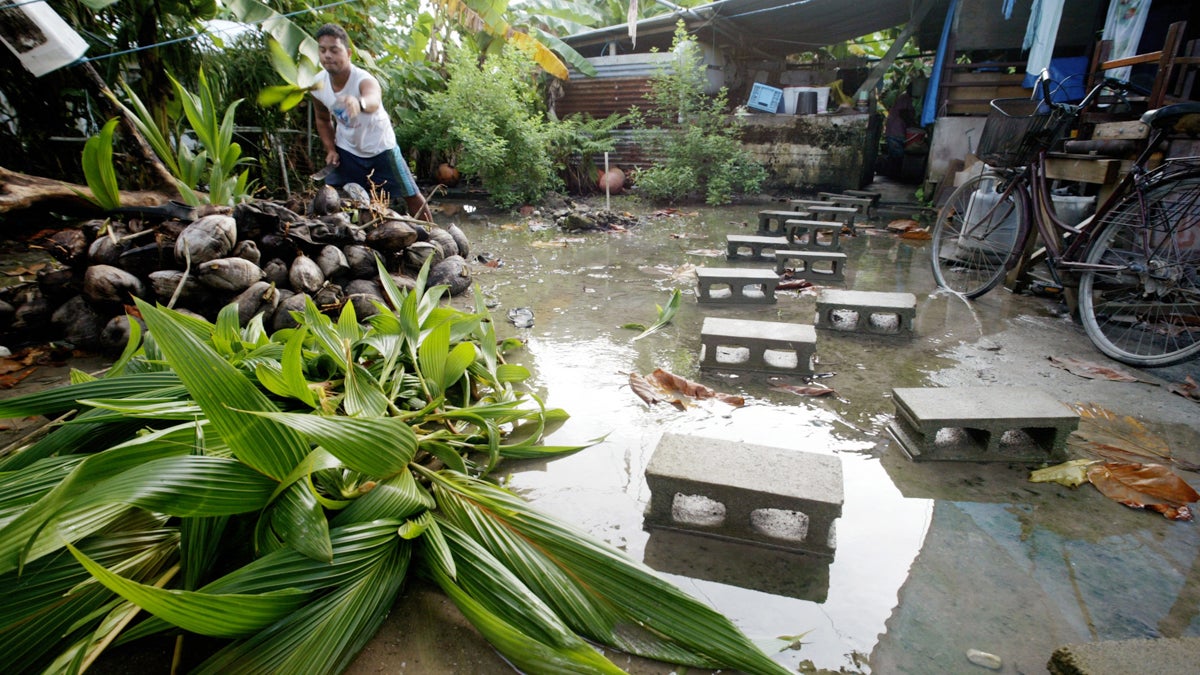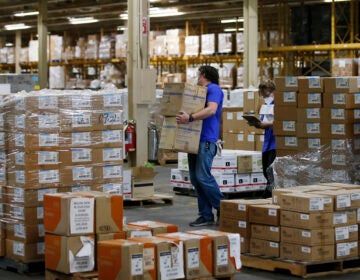Legal recognition lags as expected ‘climate refugee’ population grows
Listen 5:04
David Losia, 21, cuts coconuts for the family pigs in front of his family house flooded by the rising tides where cinder blocks are used as a makeshift walkway in Funafuti, Tuvalu. (AP Photo/Richard Vogel)
People migrate for many different reasons – war, persecution, poverty. Here’s another reason: climate change.
A 2015 report by the Internal Displacement Monitoring Centre estimated that since 2008, an average of 22.5 million people have been displaced annually by “climate or weather-related disasters.” Most move internally within their countries, though many also cross borders. According to the Intergovernmental Panel on Climate Change, that number is expected to grow.
The idea of climate migrants – climate refugees, if you will – has become mainstream. But helping people on the move due to climate change is not so easy.
Alice Thomas, who manages the climate displacement program at Refugees International, had a hard time pointing me to a climate refugee.
“You know I get interviews like where are they? Where are the climate refugees? You know, I want to go. Which camp are they in?” she said, laughing.
She said climate change likely has a hand in the erratic rains, droughts, floods and the displacement they cause, but it’s rarely the only cause for movement. “Climate change impacts are interacting with other effects to drive people from their homes,” she explained.
Ask a migrant, and most times they won’t say ‘climate change’ forced them to relocate. But, said Thomas, that’s going to change. It’s already changing.
Climate migrants in the courts
Take, for example, a case out of New Zealand. Lawyer Trevor Zohs represented a family that left the tiny Pacific island-nation of Tuvalu, in 2007, and settled in New Zealand. In 2012 they sought permanent status. They claimed to be climate refugees.
Zohs said that bid failed, because legally, there’s no such thing.
“Because climate doesn’t persecute directly,” Zohs said.
The 1951 Refugee Convention protects people persecuted by their government due to their race, religion, nationality, or membership of a particular social group or political opinion.
But Tuvalu’s government was doing everything it could to protect its people. It just couldn’t fight rising seas.
“In this particular case, the government of Tuvalu is every bit as much a victim of climate change as its inhabitants,” Zohs said.
Ultimately, the family appealed using a kind of workaround. They argued that their human rights would be violated if they were sent back to Tuvalu, both by the disruption in established relationships in New Zealand, and the potential risks of exposing their children to bad water supplies in Tuvalu. They won.
Thomas said using international human rights laws isn’t a reliable solution for others in their situation. While human rights law is a universal concept, it has no teeth. It’s up to individual countries to choose if they want to implement international laws and how. Assuming countries are going to suddenly open their arms to potentially large numbers of people who are going to be on the move isn’t realistic, Thomas said.
Even Zohs, who successfully used a human rights law in the New Zealand judicial system, said it’s not ideal. “It would seem that it’s a hope and expectation that…the courts don’t have to deal with it, that the government of the area will deal with it.”
Meanwhile, even as the family’s case wound through the courts, nearly every household on the tiny Pacific nations of Tuvalu, Kiribati, and Nauru was impacted by climate change – by floods, saltwater intrusion, storm surges. The low-lying islands could drown and disappear in the coming decades.
In other words, more families will relocate, only to find there’s no clear path forward for them.
Solutions
Various States and organizations, including Refugees International and the Office of the United Nations High Commissioner of Refugees, have started to think about what to do with the increasing numbers of people displaced by climate change related issues. So far, though, beyond a growing consensus that something should be done, few tangible solutions have materialized into action.
“We need a system, we need laws and institutions to be able to deal with this,” Thomas said. “I don’t know of one country where there’s an effective institution in place that’s working or thinking about this.”
One option is to draft an international document – like the Refugee Convention – specifically to apply to climate migrants. It’s unlikely that will happen: such agreements take a lot of time and are politically fraught. “It has a political component that is very hard to define and very hard to predict,” said Cosmin Corendea, a researcher at United Nations University.
And anyway, said Corendea, international conventions are reactive. Too late, he said. “We already know how people are reacting, we already know that people after a climate change scenario appears, they have two choices, they adapt, or they flee.”
What’s missing in international law, Corendea said, are preemptive measures.
“Even if you stop today, [the] climate change process will go on, this is scientifically proven. But we can diminish the impact of climate change upon people in different parts of the world differently,” he said.
Planned relocations in extreme cases like Tuvalu, for example. Agreements to take in climate migrants. Corendea proposes regional agreements, where countries with similar needs and outlooks can coordinate. There have been some discussions among Pacific states on how to handle climate migrants, but nothing is in place, yet.
Whether the laws exist or not, climate change induced migration is happening.
“It’s not there yet, [it’s not] visible,” he said. “But it will be.”
WHYY is your source for fact-based, in-depth journalism and information. As a nonprofit organization, we rely on financial support from readers like you. Please give today.






